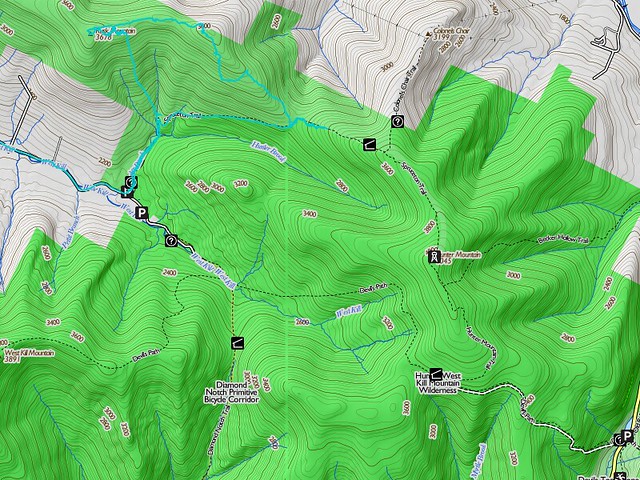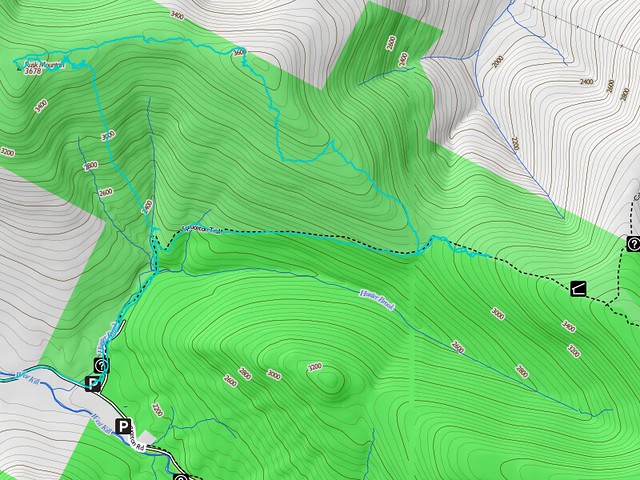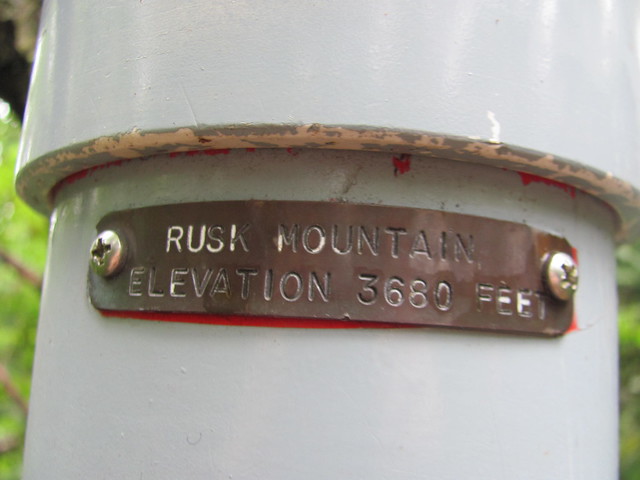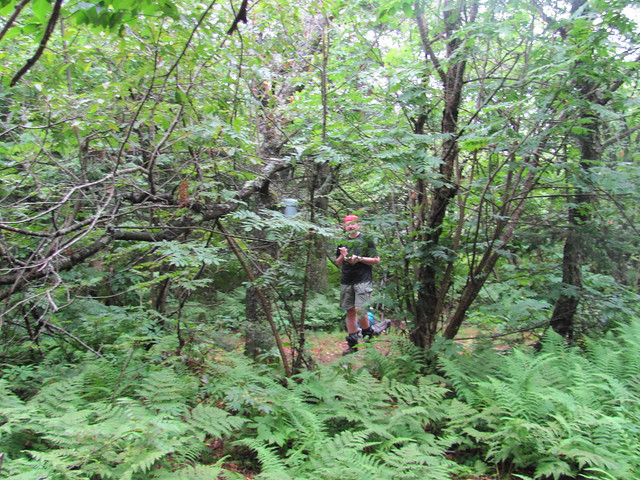Under what circumstances is carrying a PLB warranted?
I'm sure this topic has been done to death here, but a quick search of the archives surprisingly turns up only a few threads, and most of the comments there are, shall we say, not exactly nuanced. (In other words, typical WB opinions.
 ) So, with more enthusiasm than sense, I'm going to open up my very first new thread on WhiteBlaze.
) So, with more enthusiasm than sense, I'm going to open up my very first new thread on WhiteBlaze.While I'm a clueless weekender, I can sometimes be a bit of an adventurous clueless weekender, and so a week ago, my college-age daughter and I went on a weekend hike trying to bag a couple of trailless peaks in the Catskills of upstate New York. For WB'ers who aren't familiar with the territory: the Catskills are New York's answer to Pennsylvania Rocks, and are in fact made, geologically, of pretty much the same stone. Off-trail hiking on that broken rock, with the blackberries, nettles, and balsam fir in profusion, can be a trifle challenging at times. Anyway, what with one thing and another, by sundown on the first night we found ourselves still on the way down from the first peak, in the rocks and prickers, and a fair distance south of the ridge we planned to be hiking. (We weren't lost in the conventional sense. We knew where we were, and where we wanted to be: they just didn't happen to match up, because the terrain offered routefinding challenges.)
The place we found to set up camp was less than ideal, but it was the biggest flat spot we'd seen in about half an hour, so it would have to do. We managed to get warm and dry, even though we were just on the tent footprint under a rainfly, because the flat space was slightly smaller than our tent. But then my daughter turned out to be really scared by the fact that we were probably half a mile of nasty rock and prickers from where hikers, even peakbaggers, usually go. She had nightmares all night, mostly of me having a heart attack or falling off a cliff. And this kid is not new to backpacking, she's weekended with me before a number of times and enjoyed it.
When we got home (earlier than expected, because we decided when we got back to the trail that doing more peaks that weekend would not be fun), she told me that she thought she'd sleep a lot better if we'd brought a personal locator beacon along. I know that PLB's are a controversial topic, at least in other forums, and in fact, I'm of two minds on the subject. I'm writing this piece partly to share my opinions, but at least as much to clarify them in my own head and get the thoughts of others. (Knee jerks - either in the direction of "the peace of mind is worth any price", or "carrying a PLB will just make you take risks, and shows you're not accepting responsibility for yourself," will not be appreciated: I've heard them before!)
So, let me try to review the arguments:
The PLB gives peace of mind. Well, maybe. Surely - all else being equal, which it seldom is - you're safer being able to call for help than having to rely on your own resources. But it will still likely take hours or days to muster a SAR party to come and find you. How much peace of mind will that really give? But that's really a good thing; out in the woods, especially off trail, you have to be ready to rely on your own resources.
At the opposite extreme - the PLB leads to false alarms, or to "yuppie 911 calls" (OMG, we've run out of Perrier! Call Search and Rescue!) Here, I'm reasonably confident that I can resist temptation: I personally am not likely to activate a PLB in any situation where I think I have a good chance of self-rescuing. And I've been in a couple of self-rescue situations: one time in the Whites, I was caught by unforecast snow in June and had to hunker down on the lee side of a rockpile until it blew over and then posthole down by flashlight through a nice layer of wet stuff; another time, I took a fall down a talus slope and had to walk out on a badly sprained knee, leaning heavily on two companions and loopy from codeine. Both of those incidents took place before there were PLB's, but I don't see why I'd have activated a PLB if I had one; in both cases, my party could rescue itself before help could have arrived, anyway.
By the same argument, a PLB could lead to overconfidence, and taking needless risks. Since I don't like even minor accidents for which I'd easily self-rescue, I don't see where suddenly having a PLB would make me go charging off and do stupid things. I'm surely a clueless weekender, but I've been a clueless weekender for forty-odd years and I've at least learnt something about weekending. Again, I think I can resist temptation.
In the event of an emergency, it's likely the victim's fault. Setting off a PLB is endangering rescuers' lives for something that the victim could have avoided. This is getting to be a thorny area. If I carry a PLB, will I someday make a series of mistakes that means I have to use it? Surely. I'm human, and we all make mistakes. But - by the time I'm in that situation, the decision will already be out of my hands. Once I'm late enough showing up, Search and Rescue is coming after me - whatever my wishes in the matter. Because they're human, too - and trying to rescue victims, as long as hope remains and even beyond, is one of the things that humans do. By far, the most expensive part of Search and Rescue is the Search. Once you've found the victim, you know where you are, and you know what's wrong, and you have resources at your disposal. Search is facing the unknown - the victim could be anywhere, you need to cover a lot of ground, and a lot of the ground you do cover will be both difficult and fruitless. So by activating a PLB in a bad situation, I'm actually mitigating damage that I've already done: SAR is coming after me anyway, but at least I can let them know where I am, come after me with a much smaller effort, and come after me in much greater safety. I like that tradeoff.
My conclusion - On the whole, the arguments favor having the signaling device. In the end, the arguments about false alarms or overreliance on the safety net, I think, represent temptations that I can resist, and the argument that actually activating the device is reckless endangerment of the SAR forces is simply wrong.
A follow-on question is: what sort of emergency is dire enough to warrant calling in the troops? I'd say that certainly anything I'd call an ambulance, the fire brigade or the police in a city for likely qualifies. But another rule of thumb might be, "assume activating the device were a crime. Would I prefer a nice warm jail cell to the current situation?" That's also a fair working definition of an emergency. Or if "I am so impeded from traveling that SAR will come after me anyway before I can get out of here," then it's safer for everyone if I activate the PLB.
The next question is what sort of signaling device to get; it basically comes down to a 406 MHz PLB or a satellite text message device (e.g., SPOT). There are advantages and disadvantages to both:
PLB: A PLB is a single-purpose device; all it can do is scream "Help!" and give a position report. But it has a very powerful scream: under heavy tree cover, it can still be Doppler-triangulated to within a mile or better; if the cover is light enough that a GPS works, then it can give its position to less than a football field. It doesn't require a subscription to a messaging service, and it will get attention. (It will get very unwanted attention if you set it off frivolously.)
SPOT: A SPOT is considerably less reliable; it needs nearly an unobstructed view of the heavens to get messages through. But it can get a greater variety of messages out: some can even do full text messaging, and all can at least send a position report and "I'm OK" or "I need help." They need a service contract.
I'm inclined to consider a SPOT considerably less useful, because of the fact that it might not deliver a message at need (because I can't get it a clear enough view of the sky). If I'm going to devote a few ounces of weight to an emergency signal, I want it to work every time. The one major advantage I can see to a SPOT is that I can use it to send "I'm OK" messages, which may make my wife sleep more easily at all times, and hold off SAR if for some reason I'm delayed but still in good enough shape to travel.
As far as I can see it, neither one is worth the weight if I'm hiking a popular trail where there's likely to be another hiker along in a few hours. But if I'm literally wandering far from the beaten track, it strikes me that a 406 MHz PLB might well be a wise thing to spend a few ounces on.
But I'm just a clueless weekender. What do the Real Hikers think?
Read more...







